Abstract
Available methods for titrating diphtheria and tetanus antitoxin at low concentrations in human or animal blood are surveyed, with special attention to the amount of serum required for the test.
In vivo methods, especially the rabbit or guinea-pig intradermal test for diphtheria and the mouse test for tetanus, are precise and reliable. If, however, serum levels as low as about 0.001 IU/ml have to be determined, rather large amounts of serum are required: moreover, the tests are rather time-consuming and expensive.
Tissue culture methods are available only for diphtheria antitoxin titration. The titres found coincide very well with those from animal tests. The titrations are less time-consuming and more economical. These methods seem to be very promising for the replacement of animal tests. Of the real in vitro methods, the haemagglutination procedure has been investigated most thoroughly and used most frequently. Low titres can be measured using small amounts of serum, but the titres thus obtained may differ considerably from those obtained in animal tests, at least for individual sera. For mass screening, the method is very suitable.
A number of other methods are briefly discussed, but they are either less suitable or have not yet been sufficiently investigated.
Full text
PDF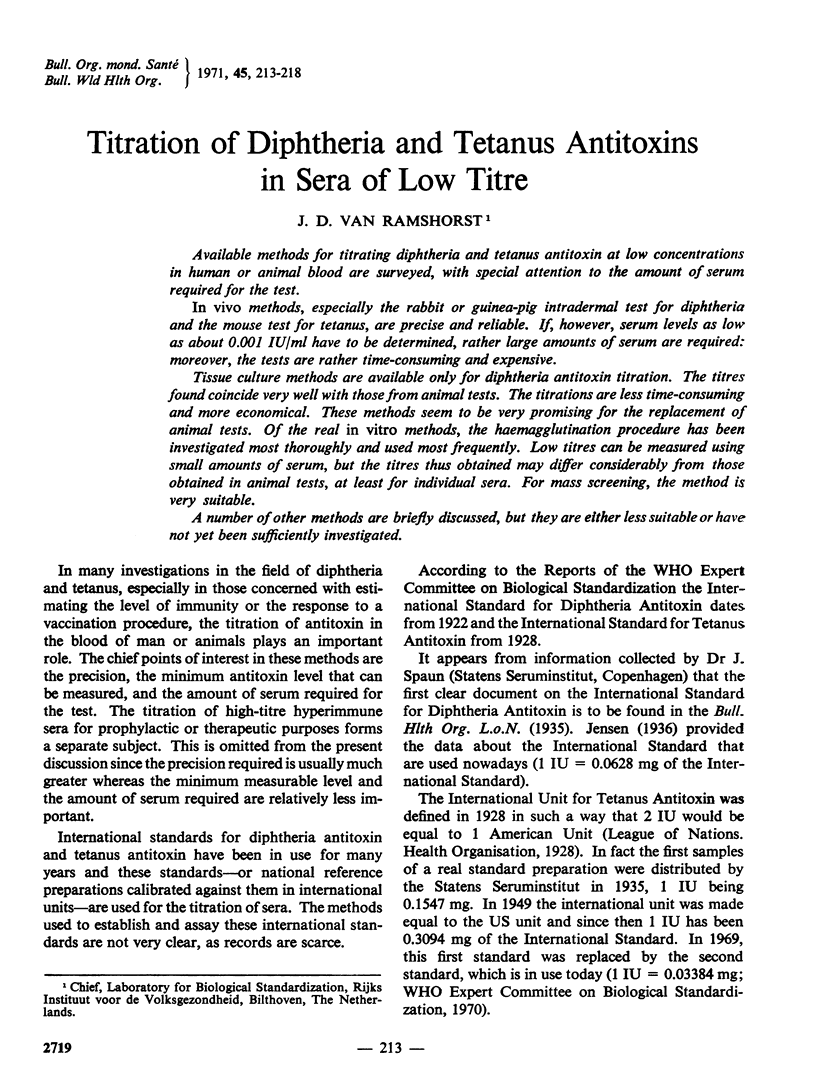
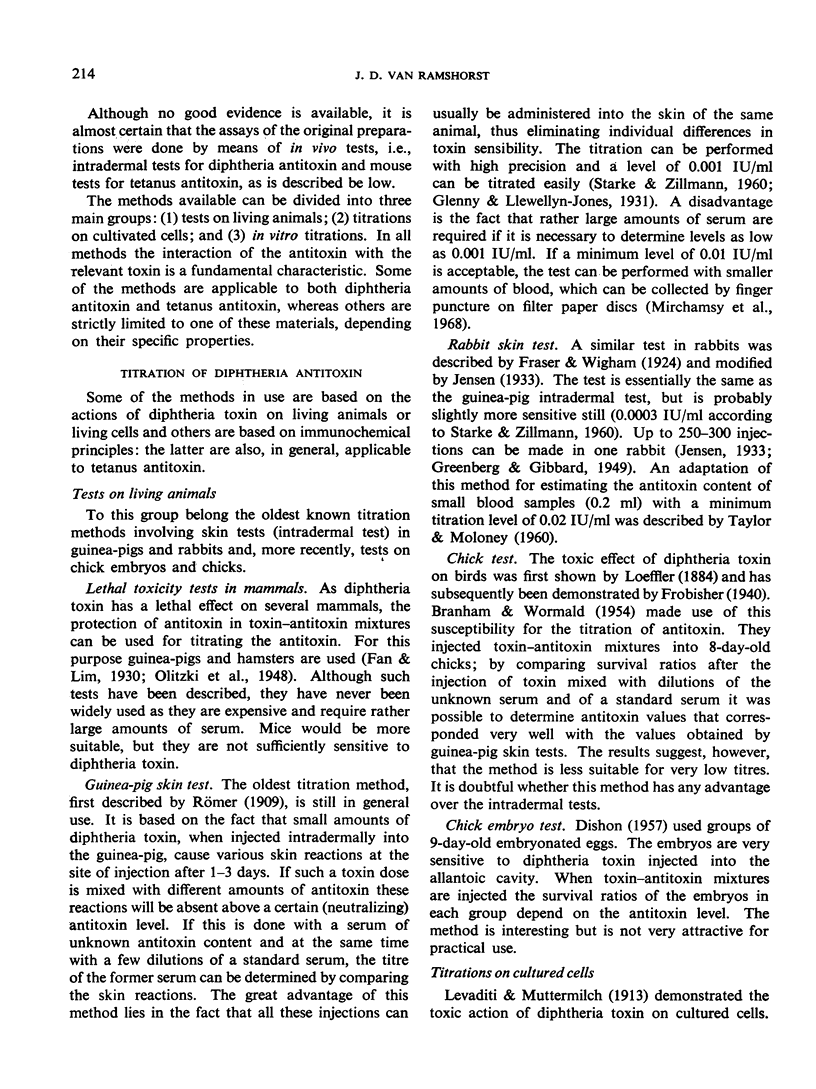
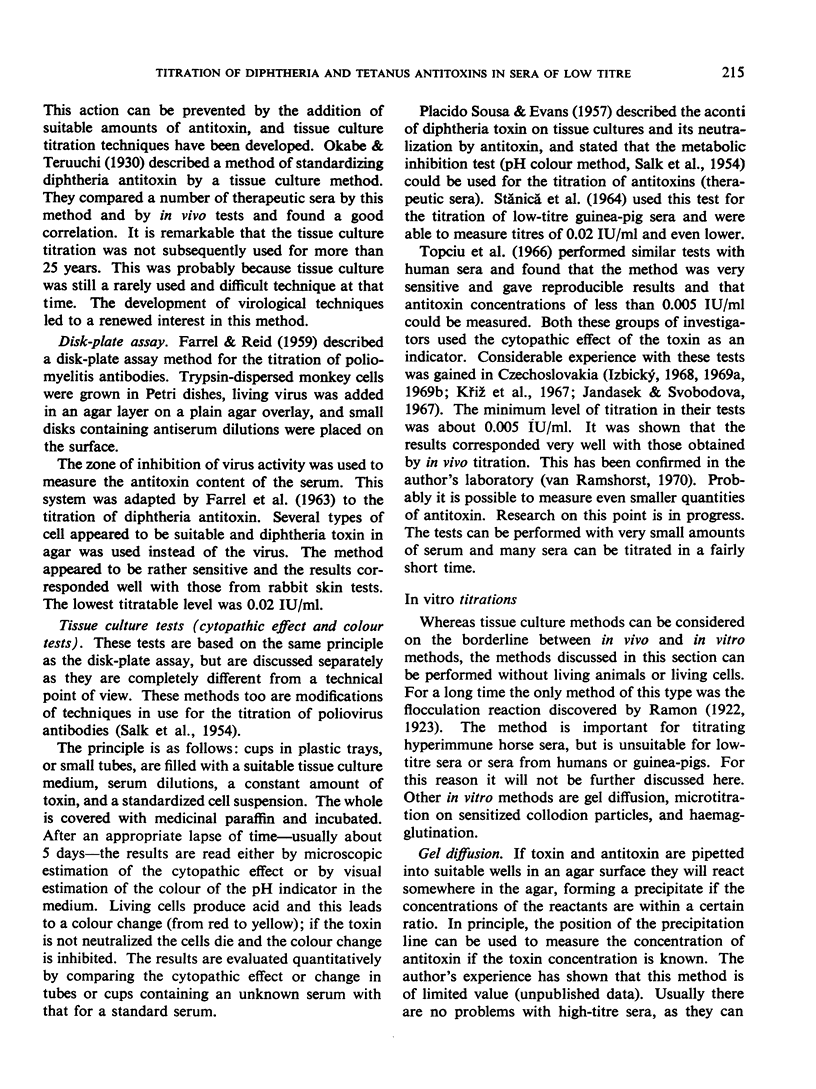
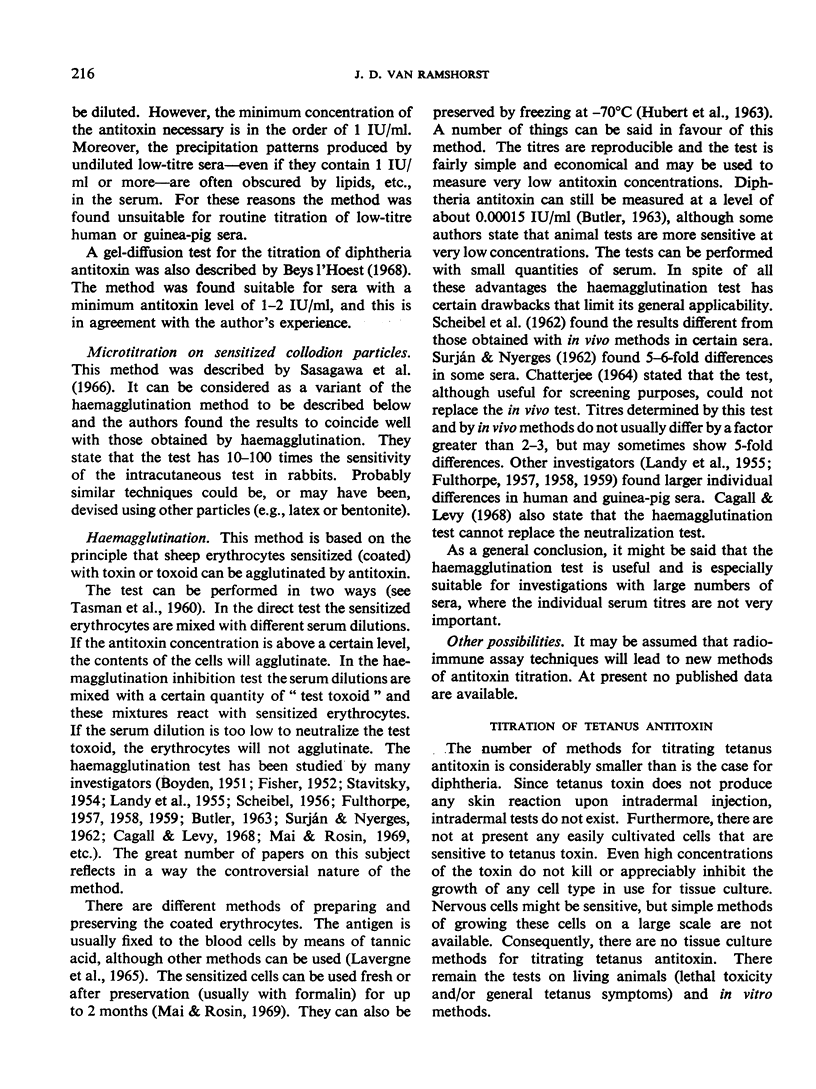
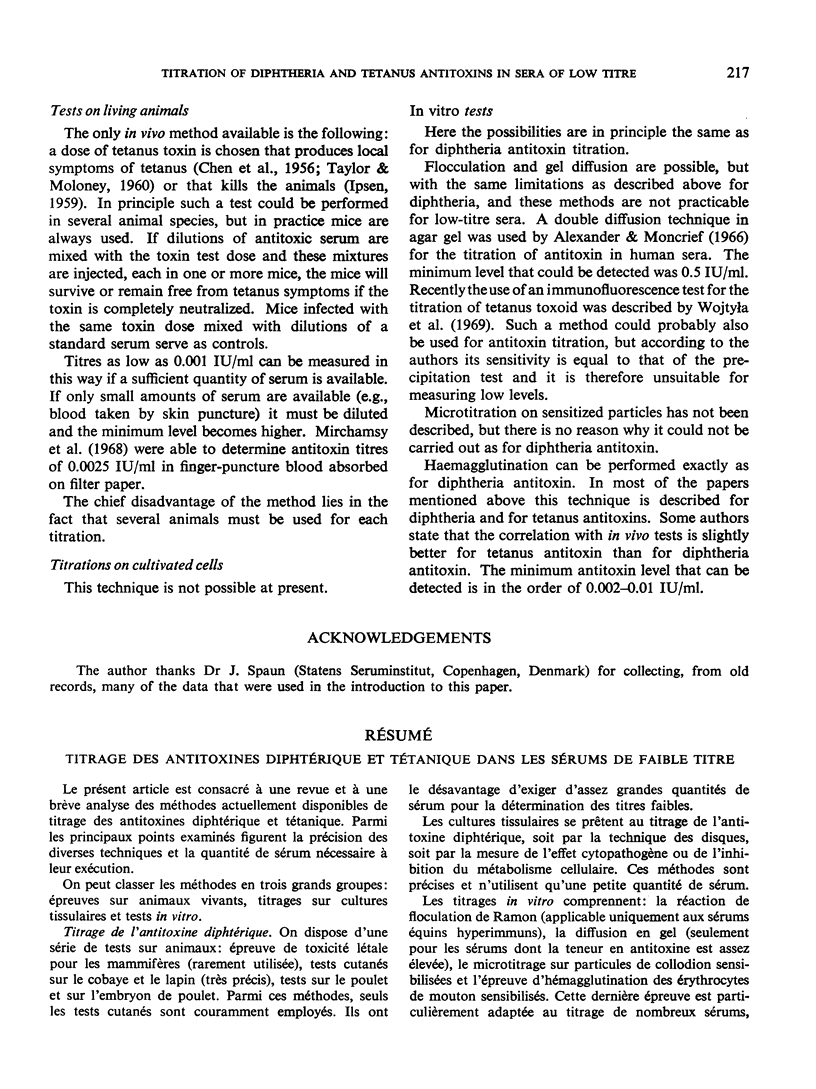
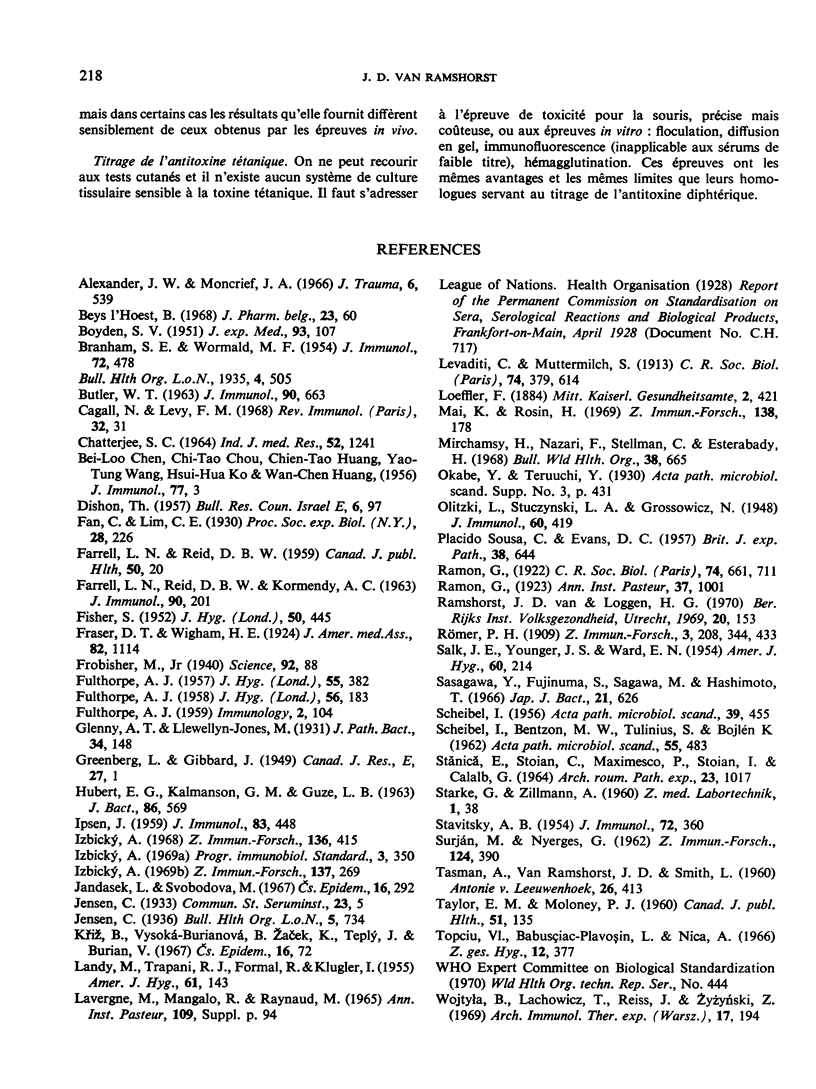
Selected References
These references are in PubMed. This may not be the complete list of references from this article.
- Alexander J. W., Moncrief J. A. Use of a simple double-diffusion technic in agar gel for the quantitation of tetanus antitoxin levels. J Trauma. 1966 Jul;6(4):539–547. doi: 10.1097/00005373-196607000-00009. [DOI] [PubMed] [Google Scholar]
- BOYDEN S. V. The adsorption of proteins on erythrocytes treated with tannic acid and subsequent hemagglutination by antiprotein sera. J Exp Med. 1951 Feb;93(2):107–120. doi: 10.1084/jem.93.2.107. [DOI] [PMC free article] [PubMed] [Google Scholar]
- BRANHAM S. E., WORMALD M. F. The use of the chick in titration of diphtheria antitoxin. J Immunol. 1954 Jun;72(6):478–484. [PubMed] [Google Scholar]
- BUTLER W. T. HEMAGGLUTINATION STUDIES WITH FORMALINIZED ERYTHROCYTES. EFFECT OF BIS-DIAZO-BENZIDINE AND TANNIC ACID TREATMENT ON SENSITIZATION BY SOLUBLE ANTIGEN. J Immunol. 1963 May;90:663–671. [PubMed] [Google Scholar]
- FARRELL L. N., REID D. B. Disc-plate assay of poliomyelitis antibodies. Can J Public Health. 1959 Jan;50(1):20–26. [PubMed] [Google Scholar]
- FISHER S. The estimation in vitro of small amounts of diphtheria antitoxin by means of a haemagglutination technique. J Hyg (Lond) 1952 Dec;50(4):445–456. doi: 10.1017/s0022172400019732. [DOI] [PMC free article] [PubMed] [Google Scholar]
- FULTHORPE A. J. Factors influencing haemagglutination tests with tetanux antitoxin. Immunology. 1959 Apr;2(2):104–111. [PMC free article] [PubMed] [Google Scholar]
- FULTHORPE A. J. Tetanus antitoxin titration by haemagglutination. J Hyg (Lond) 1957 Sep;55(3):382–401. doi: 10.1017/s0022172400037293. [DOI] [PMC free article] [PubMed] [Google Scholar]
- FULTHORPE A. J. Tetanus antitoxin tittration by haemagglutination at a low level of test. J Hyg (Lond) 1958 Jun;56(2):183–189. doi: 10.1017/s0022172400037670. [DOI] [PMC free article] [PubMed] [Google Scholar]
- Frobisher M., Jr THE SUSCEPTIBILITY OF CHICKS TO DIPHTHERIA BACILLI AND TOXIN. Science. 1940 Jul 26;92(2378):88–89. doi: 10.1126/science.92.2378.88. [DOI] [PubMed] [Google Scholar]
- HUBERT E. G., KALMANSON G. M., GUZE L. B. PRESERVATION OF ANTIGEN-COATED SHEEP ERYTHROCYTES BY FREEZING FOR USE IN INDIRECT HEMAGGLUTINATION PROCEDURE. J Bacteriol. 1963 Sep;86:569–572. doi: 10.1128/jb.86.3.569-572.1963. [DOI] [PMC free article] [PubMed] [Google Scholar]
- IPSEN J. Differences in primary and secondary immunizability of inbred mice strains. J Immunol. 1959 Oct;83:448–457. [PubMed] [Google Scholar]
- Mirchamsy H., Nazari F., Stellman C., Esterabady H. The use of dried whole blood absorbed on filter-paper for the evaluation of diphtheria and tetanus antitoxins in mass surveys. Bull World Health Organ. 1968;38(4):665–671. [PMC free article] [PubMed] [Google Scholar]
- PLACIDO SOUSA C., EVANS D. G. The action of diphtheria toxin on tissue cultures and its neutralization by antitoxin. Br J Exp Pathol. 1957 Dec;38(6):644–649. [PMC free article] [PubMed] [Google Scholar]
- SALK J. E., YOUNGNER J. S., WARD E. N. Use of color change of phenol red as the indicator in titrating poliomyelitis virus or its antibody in a tissue-culture system. Am J Hyg. 1954 Sep;60(2):214–230. doi: 10.1093/oxfordjournals.aje.a119714. [DOI] [PubMed] [Google Scholar]
- SCHEIBEL I. A comparative study on intracutaneous and haemagglutination procedures for assaying diphtheria antitoxin, with special reference to the avidity of the antitoxin. Acta Pathol Microbiol Scand. 1956;39(6):455–468. doi: 10.1111/j.1699-0463.1956.tb05073.x. [DOI] [PubMed] [Google Scholar]
- SCHEIBEL I., BENTZON M. W., TULINIUS S., BOJLEN K. Duration of immunity to diphtheria and tetanus after active immunization, with mention of non-conformity between haemagglutinating and neutralizing diphtheria antitoxin titers in some human sera. Acta Pathol Microbiol Scand. 1962;55:483–495. [PubMed] [Google Scholar]
- STAVITSKY A. B. Micromethods for the study of proteins and antibodies. I. Procedure and general applications of hemagglutination and hemagglutination-inhibition reactions with tannic acid and protein-treated red blood cells. J Immunol. 1954 May;72(5):360–367. [PubMed] [Google Scholar]
- SURJAN M., NYERGES G. Haemagglutination procedure for the assay of tetanus antitoxin of children's sera. Z Immun exp ther. 1962 Dec;124:390–400. [PubMed] [Google Scholar]
- Sasagawa Y., Fujinuma S., Sagawa M. [Micro-titration of diphtheria antitoxin by sensitized collodion particles]. Nihon Saikingaku Zasshi. 1966 Oct;21(10):626–628. [PubMed] [Google Scholar]
- Stănică E., Stoian C., Maximesco P., Stoian I., Calalb G. Contribution au titrage de la toxine-antitoxine diphtérique sur cultures de tissus. Arch Roum Pathol Exp Microbiol. 1964 Dec;23(4):1017–1024. [PubMed] [Google Scholar]
- TASMAN A., van RAMSHORST J., SMITH L. Determination of diphtheria and tetanus antitoxin with the aid of haemagglutination. Antonie Van Leeuwenhoek. 1960;26:413–429. doi: 10.1007/BF02539029. [DOI] [PubMed] [Google Scholar]
- TAYLOR E. M., MOLONEY P. J. Assay of diphtheria and tetanus antitoxins in small volumes of blood. Can J Public Health. 1960 Apr;51:135–138. [PubMed] [Google Scholar]
- Topciu V. L., Babuşceac-Plavoşin L., Nica A. Titrierung des antidiphterischen Antitoxins auf Zelkulturen. Beziechungen des Antitoxin-Serumtiters und Schick-Reaktion. Z Gesamte Hyg. 1966 May;12(5):377–381. [PubMed] [Google Scholar]
- Wojtyla B., Lachowicz T., Reiss J., Zyzyński Z. Tye use of the immunofluorescence adsorption test (IFAT) for titrating tetanus anatoxins. Arch Immunol Ther Exp (Warsz) 1969;17(2):194–199. [PubMed] [Google Scholar]


